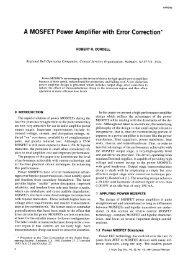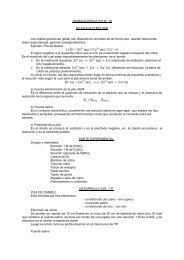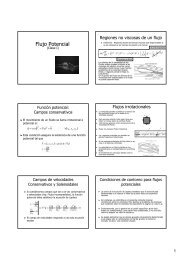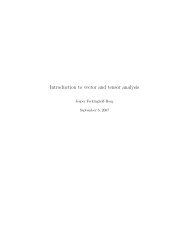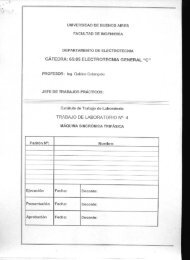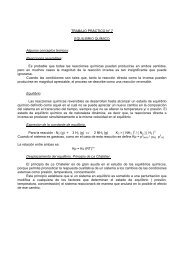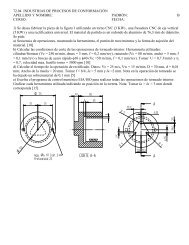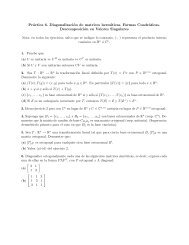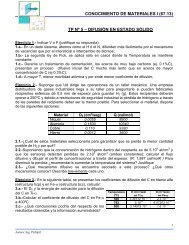Download PDF
Download PDF
Download PDF
Create successful ePaper yourself
Turn your PDF publications into a flip-book with our unique Google optimized e-Paper software.
Ahlbom<br />
Table 8. Certain characteristics and findings of studies on the relation between EMF exposure and depression.<br />
Definition and<br />
Study<br />
Reference Study base and subject identification estimation of exposure design Numbers Result RR (95% CI)<br />
Dowson et al., 1988 Persons in England who lived near 132-kV Distance between home Cross- 132 near power line, 9 with Strong association<br />
(171) power line and persons who lived 3 miles and overhead power line. sectional depression; 94 away from between depression<br />
away. Questionnaire asking about depression. power line,1 with depression and proximity to<br />
overhead power line<br />
Perry et al., 1989 Persons with depression discharged Measurements at front CC 359 patients discharged with Average measurement:<br />
(172) from hospital in England; controls from doors. Average for case and diagnosed depressive illnesses Cases: 2.3 mG<br />
electoral list. control groups compared. Controls: 2.1 mG<br />
Poole et al., 1993 Residents in 8 towns along a trans- Distance from power line: Cross- 382 persons interviewed 2.8 (1.6–5.1)<br />
(173) mission line right-of-way in the U.S., 1987. near vs far. Near: properties sectional<br />
A sample was interviewed. Depressive abutting right-of-way or visible<br />
symptoms were identified by CES-D. towers.<br />
Cutoff for depression was median of score.<br />
Savitz et al., 1994 Male veterans who served in the U.S. Army Present job identified in inter- Cross- 183 electrical workers, 13 with 1.0 (0.5–1.7)<br />
(174) for the first time, 1965–1971. Two diagnostic view together with duration. sectional lifetime depression; 3,861<br />
inventories were used: the Diagnostic Electrical worker. nonelectrical workers<br />
Interview Schedule and the Minnesota<br />
Personality Inventory. Lifetime depression<br />
used for report here.<br />
McMahan et al., Population of neighborhood near a trans- Average EMDEX measure- Cross- Total of 152 women 0.9 (0.5–1.9)<br />
1994 (175) mission line in Orange County, California, ments at the front door: sectional<br />
USA, 1992. Sample of homes near and one Homes on easement: 4.86 mG<br />
block away from power line. Depressive One block away: 0.68 mG<br />
symptoms identified through questionnaire<br />
and CES-D scale.<br />
Verkasalo et al., Finnish twins who answered the BDI Residential magnetic field Cross- 12,063 persons BDI scores not<br />
1997 (176) in 1990. estimated from power lines sectional related to exposure<br />
near the homes.<br />
Abbreviations: BDI, Beck Depression Inventory; CES-D scale, Center for Epidemiologic Studies–Depression scale.<br />
approximately 139,000 male utility workers<br />
(180). In this study it was hypothesised a priori<br />
that long-term exposure to magnetic fields<br />
leads to an increased risk of death due to cardiac<br />
arrhythmias and acute myocardial infarction.<br />
Primary cause of death was taken from<br />
the death certificate; exposure was assessed<br />
according to the duration of employment in<br />
occupations with high exposure to magnetic<br />
fields, and by cumulative exposure, building<br />
in various lag periods. Although overall cardiovascular<br />
disease and ischemic mortalities<br />
were lower in the study cohort than in the<br />
U.S. population, deaths from arrhythmiarelated<br />
conditions and acute myocardial<br />
infarction were related to increasing exposure<br />
5–20 years before death, using both indices.<br />
The specificity of the study hypothesis,<br />
which was crucial to the findings, arose out<br />
of evidence (although inconsistent) from<br />
human laboratory studies that a pattern of<br />
reduced heart rate variability occurred immediately<br />
after exposure to power-frequency<br />
magnetic fields (181). Reduction in heart rate<br />
variability is reported to be predictive of cardiovascular<br />
disease and death in adults in<br />
population-based studies (182–184).<br />
Changed heart rate variability reflects<br />
changed cardiac autonomic control<br />
(185,186), suggesting that this is a possible<br />
mechanism of action of EMF exposure on the<br />
heart. The limitations of speculating about<br />
causal mechanisms of types of CVD as coded<br />
on death certificates of uncertain validity and<br />
reliability have been pointed out (187). Also<br />
there are difficulties in explaining how the<br />
mechanism underlying the transient changes<br />
in heart rate variability seen in healthy young<br />
men after EMF exposure in controlled settings<br />
(181,188) can also explain deaths from<br />
arrhythmia and infarction many years after<br />
long-term occupational exposure to ELF<br />
EMFs. Indeed, a recent large study conducted<br />
in Sweden has shown no effect of EMF<br />
exposure on myocardial infarction (189).<br />
Interpretation and conclusion. In summary,<br />
evidence of cardiovascular effects due<br />
to elevated exposure to magnetic fields is<br />
weak, and whether a specific association exists<br />
between exposure and altered autonomic control<br />
of the heart remains speculative until corroborating<br />
evidence from further large<br />
epidemiologic studies becomes available.<br />
Reproductive Effects<br />
In the 1980s, laboratory findings were<br />
reported showing that weak (approximately<br />
1 µT) magnetic fields may adversely affect<br />
chick embryogenesis (190,191). In addition,<br />
clusters of adverse pregnancy outcomes<br />
were reported among users of video<br />
display terminals (VDTs ) (192), and epidemiologic<br />
data were published suggesting<br />
that maternal use of electric blankets and<br />
water beds may influence fetal development<br />
(193). Subsequently, several studies of the<br />
effects of EMF exposure on reproductive<br />
health have been conducted (194).<br />
Residential exposure. Studies investigating<br />
the reproductive effects of residential exposure<br />
to ELF magnetic fields have evaluated<br />
either exposures to general residential magnetic<br />
fields or to specific sources, namely<br />
heated waterbeds, electric blankets, and<br />
ceiling heating coils.<br />
Several studies have been conducted of<br />
various reproductive end points in relation to<br />
general residential exposure. With regard to<br />
spontaneous abortion, high-intensity magnetic<br />
fields measured at the front doors of<br />
homes of volunteers’ homes in a “work and<br />
fertility” cohort study in Finland, were associated<br />
with a marginally significant, 5-fold<br />
increased risk (based on fewer than 10 cases<br />
and adjusted only for smoking status) (195).<br />
Two later studies, Savitz and Anath (196) and<br />
Belanger et al. (197), found no increase in risk<br />
of spontaneous abortion however. An investigation<br />
arising out of a case–control study of<br />
childhood cancer, found pregnancies in<br />
homes with a magnetic field intensity >0.2 µT<br />
were no more likely than others to end in<br />
spontaneous abortion (196) (again small<br />
numbers of cases and design limitations weakened<br />
the results). Similarly in a prospective<br />
study of nearly 3,000 women in New Haven,<br />
Connecticut, intrauterine growth rate (IUGR)<br />
and spontaneous abortion were unrelated to<br />
wire code of maternal residence (classified as<br />
928 VOLUME 109 | SUPPLEMENT 6 | December 2001 • Environmental Health Perspectives



